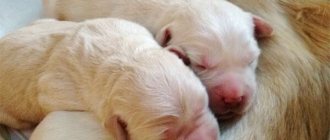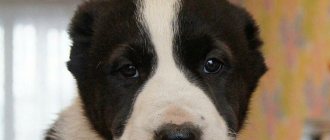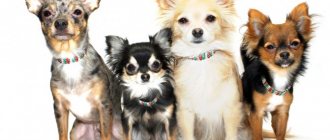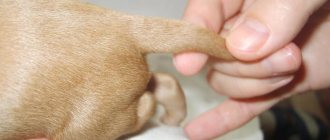Poodles are an ideal pet for pets. They are active and playful, good with children and have high intelligence. That is why representatives of this breed often perform demonstration acts in the circus, as they love attention and are ready to quickly learn any tricks. Today there are several varieties of this breed, including miniature poodles, which are very small in size and are well suited for keeping in a small apartment.
Everything you need to know about toy poodle sizes
The Toy Poodle is the smallest breed of the four varieties of Poodles that exist.
You simply won't find a better lap dog. The toy poodle feels great in the apartment. The dog practically does not shed, is not aggressive towards children, and is easy to train. Many who decide to buy themselves a four-legged friend, after a while acquire a couple more dogs. And instead of one baby, a whole “flock” is running around.
From the history of the appearance of the breed
The toy poodle was bred from the regular poodle, which is not classified as a toy poodle. The service-sporting breed does not have a standard. It first appeared in the 20th century.
The breeders were faced with the task of breeding the smallest poodle and giving it decorative properties. After years of experience, toypoodle was officially registered by the FCI in 2007. A description of the breed with a photo is posted on the official website of the association.
According to unofficial data, the dwarf toy poodle was brought by sailors from Central Asian countries. The hypothesis has no official confirmation.
Growth standard
The toy poodle is a short dog, playful and tireless. The name of the breed is translated from English as “toy”. It is a copy of the dwarf, only slightly smaller in weight and height. Therefore, when choosing a baby, it is important to see his parents and check the documents so that instead of one breed you do not buy another.
The permissible height of a toy poodle at the withers should be no higher than 25 cm, although 28 cm can be found, but no more.
Depending on the variety, poodles can reach a height at the withers of up to 60 cm.
Price range
Puppies should be purchased at two months of age. If you plan to exhibit your pet at exhibitions, then it is recommended to buy a four-month-old individual. The nursery, like the official breeder, issues a puppy card and a vaccination certificate. Afterwards these documents are changed to a pedigree.
If the pet is a show pet and meets the standards established by the federation, then its price varies between $750-1300.
Individuals for breeding are sold for $500-700. If there are visible deviations from established standards, the price will be from $400. Without documents, a toy poodle puppy will cost $100-200.
Puppy parameters by month
If a family has a baby toy poodle, it is very important to monitor its development and weight. There are owners who believe that if you feed the dog less, then it will grow smaller.
You should take the indicators calmly; each baby grows individually. Some gain weight quickly and stop growing at three months of age; puppies from another litter can grow up to two years.
Table
| Month | Dimensions |
| 1 | The dog's weight will depend on the weight of his mother. A standard puppy weighs about 200 grams at birth; by the end of the first month, with good nutrition, it gains weight up to 650 grams. |
| 2 | By two months he can gain weight up to 1100 grams. The height of the dog reaches 16 cm, no more. |
| 3 | At this age, the number of feedings is reduced, weight at this age increases by 500 grams and is almost 1.6 kg. The toy poodle grows up to 18-19 cm at the withers. |
| 4 | In the fourth month of life, the baby continues to actively gain weight. Now he reaches 1900 grams, reaching approximately 21 cm at the withers. |
| 5 | The older the baby gets, the less he continues to gain. At four months the weight reaches 2200 grams and reaches up to 23 cm at the withers. |
| 6 | The puppy is approaching 2.5 kilograms, his height increases by a couple of centimeters. By six months, the pet has almost reached its ideal standard of 25 cm. |
There is always a chance that instead of the coveted toy poodle puppy, you will be sold a representative of the dwarf breed. It is very easy to confuse them, they are perfectly similar, only after 4 months will it be clear whether it is the same or not. If the pet at this age is not higher than 20 cm, then you are lucky.
When choosing a toy poodle puppy, you should definitely pay attention to the following points:
- There are no documents. Various reasons can be given - there was no time to do them, it was expensive, etc. This is the first sign that the baby may be sick or not purebred.
- Lack of documents confirming the breeding of dogs or at least its planning.
- There are no documents indicating vaccinations or information that the puppies have been treated for parasites. There are cases that breeders, in order to pass off another breed as a toy poodle, do not feed the puppies and infect them with viruses and parasites. This affects their development.
- You should be wary if breeders do not show the parents of their offspring.
- The mother of the puppies must be at least 2.5 kilograms.
- Do not be persuaded to buy the smallest puppy; there is no chance that it will grow up to be large, as the breeder promises.
Basic care rules
In order for your puppy to grow up healthy and happy, you need to care for him by following some rules:
- In the first days, be extremely attentive to the puppy and be affectionate with him. It was hard for him to move to a new house; he misses his mother and brothers. You must show him that you do not pose any danger, but on the contrary.
- If there are children in your house, then it is worth explaining to them that the animal is not a toy. You should not disturb him while he sleeps or pull his paws or ears. Show how to properly handle your new pet.
- The pet must have its own place to sleep and rest. Don't disturb him if he settles on it to catch his breath.
- The dog should have its own toys. As he grows up, he will have a need to chew on something and play with something. It would be better if it were his things than yours.
- Make sure that there are no things valuable to you or anything small that are dangerous for him on the floor or in the dog’s access area.
- Start teaching him his name and hygiene procedures: trimming his nails, cleaning his ears, rubbing his eyes, and checking his teeth. He must get used to the fact that such things will be repeated regularly.
- When walking outside, do not let your puppy pick up any objects from the ground, especially not eat or chew them. Do not let your dog off the leash unless you are sure that it is accustomed to you and will not rush after the first car or cyclist.
- The puppy should always have clean water freely available.
- Do not forget how many times a day you need to feed the puppy, and also that gradually the number of meals should be increased to twice a day.
Deviations
When purchasing a pet, pay attention to its appearance. Sign of dwarfism:
- large, flat head;
- head too round;
- limbs are curved;
- hunchback is observed;
- the back sags;
- muzzle flattened;
- the paws are very loose.
You should not adopt a puppy with such signs, he is sick.
The pet is human-oriented, playful but obedient. To avoid problems with deception, you can purchase an adult dog. But, if you want to raise a puppy from a young age and to suit yourself, then you need to study all the intricacies of choosing this breed.
Remember that every representative is unique. A dog may not always fit within the accepted standards.
How to choose a puppy
If you have a sufficient budget, it is recommended to give preference to time-tested breeders. Private nurseries are not a guarantee of buying a healthy puppy.
Before choosing, you should watch the four-legged animal you like for some time. A healthy individual will be active, curious and playful.
Males are more active by temperament. The bitches are acting calmer. The smallest puppy may be weak.
Rash and redness are a sign of improper care of the animal. The tummy should be soft and the eyes should be clean and clear. Everything under the tail should be clean and dry.
How old do dogs grow?
Intensive growth in dogs is observed until 6 months of age, then the rate decreases. The further development of healthy dogs kept in appropriate conditions depends on the breed and size. Let's look at the growth characteristics of small, medium and large dogs.
Small breeds
Small dog breeds include:
- Yorkshire Terrier - growth lasts up to 8–9 months.
- Pekingese - up to 9 months, sometimes up to 12 months.
- Chihuahuas grow in height for up to 8 months, then gain strength.
- Pug - up to 6 or up to 9 months with active weight gain.
- Toy terrier - up to 180 days.
- Toy poodle - growth continues until 7-8 months.
- Pomeranian Spitz - its growth ends at 6 months, after which the bones become stronger.
- Dachshund - up to 8 months in height, then gets stronger.
- Staffordshire Bull Terrier - up to 7 months, growth stops by 10-12 months.
- Shih Tzu - grows at 4-6 months.
Medium breeds
Medium breeds of dogs grow until about 12 months of age; in terms of breeds it looks like this:
- Spaniel - about 8 months, matures up to 1.5 years. Cocker Spaniel
French bulldog - up to 8-9 months, then grows in breadth.
Puppy at birth
Newborn babies are entirely dependent on the mother dog: the kittens are blind and deaf, sleep most of the day, and suck milk during short periods of wakefulness. Puppies cannot yet regulate their own body temperature, but are already sensitive to smells and touches. The babies just slowly crawl, turn their heads in search of their mother’s nipples, whine, looking for her. It is still difficult for them to maintain the weight of their own body.
The weight of puppies at birth depends on the characteristics of the parents, proper care of the mother during pregnancy, the number of babies in the litter, and genetic predisposition. The average weight of newborns is 150-200 g.
Toy poodles appear in the litter of miniature (formerly called dwarf) members of the breed. In the first days of a dog’s life, even a specialist cannot determine its future. The smallest kitten in the litter may not grow up to be a toy, but a miniature poodle.
Newborn toy poodles:
How to determine a dog's age
There are cases when the owner does not know the date of birth and age of his pet, and this indicator is important from the point of view of the start and frequency of vaccinations, sterilization, castration, training, care and feeding.
In order to approximately determine the age of an animal, there are the following methods:
- Look at the teeth . A young animal 1 year old has white, clean, healthy teeth, a 2-year-old has yellow teeth, a 3-5-year-old has tartar, a 6-year-old has worn fangs, concave incisors, and over 8 years old have blunt fangs. Old dogs' teeth begin to fall out. Teeth change between the ages of 2 and 6 months.
- Inspect the wool . The older the animal, the harder it feels to the touch. As you get older, your fur begins to turn grey.
- Touch and examine the muscles . Flaccid muscles are a sign of an aging animal. The older the dog gets, the less he moves and the more he sleeps.
- Look into your eyes . With age, the eyes begin to water and become dull, while the gaze of young dogs becomes clear.
Video: how to find out the age of a dog
Description of the breed with photos
The FCI standard defines the conformation of the average poodle. The document contains the following basic requirements regarding the appearance of the animal.
- The head with thin skin is proportional to the body.
- Oval skull with a round forehead.
- Short muzzle.
- The lips are not droopy and match the color.
- Correct bite.
- Large nose with wide nostrils.
- Almond-shaped eyes are dark brown.
- The drooping ears touch the lips.
- Proportional physique.
- Wide chest.
- Flat back with muscular lower back.
- Strong limbs.
- The joints are well developed.
- Oval hands with webbed fingers.
- High tail.
Size and weight
The weight of an adult can reach 12 kilograms . The minimum indicator mark is 9 kg. Height at the withers is from 35 to 45 centimeters . Females are slightly smaller in size than males.
Coat type
The poodle has two types of coat:
- curly; The dog's hair is curly and thin, but the coat is quite thick;
- corded; straight and hard hairs, densely located to each other.
Variety of colors
Purebred poodles only come in solid colors. The standard for medium-sized representatives of the breed provides for five colors.
- Black poodle.
- White medium poodle.
- Brown (no chocolate tint or light spots).
- Gray or silver (without transitions or overflows).
- Apricot (without transitions to beige or brown).
Misconception: Why is my dog not growing?
Dog owners are often mistaken about their pets, and this also applies to their size. In this regard, they begin to look on forums for an answer to the question of why the dog is not growing, forgetting that this is impossible.
Owners often fall into misconceptions about the size of puppies:
- The puppy has stopped growing and will be a dwarf . This is not true: puppies grow actively until they are 6 months old, then growth and weight gain occur less actively and unevenly. The indicator can also be affected by illness, lack of physical activity, and lack of vitamins.
- A small animal cannot protect me . This is not true: height and defensive ability are in no way dependent on each other. A dog trainer is able to train any animal to resist attacks on you.
Owners should understand that a puppy cannot stop growing, they just don’t notice it. If you show a puppy to someone who hasn't seen it for a while, they will definitely notice a change in appearance.
Even if you regularly take measurements and write down readings, it may turn out that the dog has relaxed his muscles a little, twisted, the ruler has moved out of place, etc.
In order for your dog to be physically developed, he needs to be fed properly and actively walked, and in order to protect you, he needs to be trained and be a friend to the dog.
Thus, the growth process of a dog goes through several stages. It is important that puppies can grow at the withers up to 1.5 years of age, and the larger the breed, the longer growth will continue. By the age of 3 years, the puppy will acquire the appearance of an adult animal.
Don’t worry too much about your pet’s growth—everything has its time, and a dog of any size will be able to protect you.
How to toilet train?
Toilet training a puppy should be done in several stages:
- Set up a place where your dog can go when he needs to. This can be done even before it appears.
- Remember that babies go to the toilet often. Watch and you will see that this happens after every meal. If the puppy begins to sniff the floor and spin around restlessly, then it’s time to take him to the place that you have equipped for him. If he did everything right, then praise him with a treat.
- If your pet still didn’t have time or didn’t make it, then don’t rush to punish or scold him. Remember that he is still a child and does not quite understand what they want from him.
- If you see that the dog has started doing business in the wrong place, then shout sharply to it and immediately take it to the toilet. There, if everything ends successfully, praise him.
- Once your pet has received all its vaccinations, you can train it to go to the toilet outside. Remember that puppies often have to manage things, so at first you will have to walk him 5-6 times a day. Whenever successful, praise him and give him a treat.
- First, go for walks with him at the same time so that he gets used to the walking schedule. If you see that he asks outside your walking period, then take him for a walk anyway.
- Don’t rush to remove the litter box right away, because the dog won’t be able to tolerate it for long. As he gets older, he will need to go to the toilet less often, only then his place in the house can be cleaned.
NOTE!
Toilet training is an important period in a dog's life. You need to show as much patience as possible and not go too far with punishments. It is absolutely forbidden to hit a puppy, this will have a negative impact on his psyche.
How many years can a poodle live?
Good immunity, proper care and comfortable living conditions allow these curly pets to delight their owners with their presence for a long time.
The average life expectancy of a poodle largely depends on the size of the dog:
Interesting! Among the representatives of this breed there are real long-livers. One of them was the toy poodle Seamus, who lived for 20 years.
brief information
The Toy Poodle is characterized as a cute and incredibly elegant breed. A characteristic feature is the presence of unruly curls and small size.
The pet’s cheerful and good-natured disposition, as well as its intelligence, deserve special attention. Externally, the Toy Poodle resembles the Royal Toy Poodle. Breed Features:
| Criterion | Breed characteristics |
| Year of origin | 1936 |
| Country of origin | France |
| average life expectancy | 15-18 years old |
| Bitch height | 20-25 cm |
| Male height | 22-28 cm |
| Average weight of a female | 1.7-4.5 kg |
| Average male weight | 2-5 kg |
| Cost of a toypoodle puppy (without documents) | 10,000 rubles |
| Cost of a toypoodle puppy (with documents) | 130,000 rubles |
This pocket dog is not subject to shedding, despite the abundance of curls on its body. Its fur does not have a specific aroma. The small size and charming appearance have made the toypoodle breed popular among the elite.
How to find out the age of a pet
It often happens that a dog ends up in another home no longer a puppy. To get at least some idea about the animal, the new owner needs to establish the approximate age of the dog.
The most accurate way to find out how old a poodle is is to assess the condition of its teeth:
- In young dogs that are 1-2 years old, they are white and sharp. The protrusions of the incisors are shaped like a trefoil.
- After 2 years, teeth begin to gradually wear down. Natural whiteness fades.
- By the age of 4, a poodle's teeth will develop a grayish tint. The protrusions on them become barely visible.
- After 5 years, representatives of this breed wear down their fangs. Yellow discoloration appears on the teeth.
- By 6-8 years, your pet’s incisors become concave at the edges. The fangs become completely dull. Plaque increases on the teeth.
- At 8-10 years of age, the toes become oval. The fangs wear out a lot. The teeth turn completely yellow. Sometimes they acquire a brownish tint.
- By age 12, a poodle's teeth begin to loosen and fall out.
You can determine the approximate age of a dog by the condition of its coat, eyes and behavior.
Young poodles are active and energetic. They have developed muscles and are not overweight.
Older animals rest more, move little and hardly play. Their muscles lose tone and become flabby. Dogs develop obesity.
The eyes of young representatives of this breed are bright and shiny. By the age of 7 they become dull.
When young, the poodle's coat is thick and soft to the touch. It is curled into thin cords or styled into bouncy curls that hold their shape well. In older dogs, the coat becomes duller and brittle. It fits worse and is starting to turn grey.
More about poodles
The conditional classification of poodles can also be based on criteria such as color and type, which can play a decisive role when choosing a puppy. Let's find out what dog options are possible in these cases.
Small dog breeds also include Norwich Terrier, Griffon, Lhasa Apso, Chihuahua, Japanese Dwarf Spitz, King Charles Spaniel, Yorkshire Terrier, Jack Russell Terrier, Papillon, Biewer York, German Spitz, Welsh Terrier, Maltipoo.
By color
Undoubtedly, all representatives have a certain charm and are distinguished by their peculiar grandeur, but white dogs are deservedly considered the most attractive and elegant. If you have already tried to find out everything possible about the breed, you have probably noticed that in this case many other color variations are recognized as the standard. With the mentioned white poodles there are much more worries due to their tendency to quickly get dirty, so they are preferred mainly by very clean people.
Dreamers and connoisseurs of beauty will like pink or apricot colors, and from a practical point of view, black or rare brown representatives will be an excellent option. If you wish, you can even buy a gray poodle, which will become a kind of golden mean, especially since such dogs look quite unusual and original.
Among the unrecognized in the world is the brindle coat color, and the merle (marble) color is also absent from the genotype.
Did you know? The fashion for poodles in the USSR appeared during the reign of Khrushchev, after Queen Elizabeth II gave him a dog of this breed.
By type of wool
And finally, connoisseurs of the breed probably know about the differences between its representatives in the appearance of their coat. Usually on the streets you can find curly pets, neatly trimmed and fluffy, but another option is possible - corded poodles. Occasionally there are representatives of the breed with a wavy coat. The most common curly coat consists of fine, soft and elastic hair that springs back under hand pressure. Curls of different sizes look very neat.
No matter what kind of poodle you buy (large, medium or very small), size is far from the main thing. In any case, you will get an intelligent and devoted pet who will undoubtedly give all his love, demanding in return only a little affection and attention.
How to extend a dog's life
In order for a cheerful, curly pet to delight its owners with its presence for a long time, it needs to be taken care of.
Proper maintenance, proper care, a nutritious diet and regular visits to the veterinarian are important not only for the elderly, but also for the young poodle.
The right diet
How long a poodle will live depends on what it eats. When preparing your pet's diet, you need to include all the products that are necessary for the dog's health.
These include:
- Meat. Beef and lean lamb are especially beneficial for poodles. Meat should make up two-thirds of a dog's diet.
- Offal. Twice a week, meat feeding is replaced with boiled beef liver or heart.
- Sea lean fish. Before putting it in the dog's bowl, the bones are removed from it.
- Cereals. Rice, millet and buckwheat will be of particular benefit to your pet. Semi-liquid porridges are cooked from them.
- Dairy products. Several times a week, the dog is given low-fat cottage cheese, kefir or yogurt. These products replenish calcium deficiency.
- Vegetables. They are given boiled or raw. Cabbage, beets, celery, carrots and greens are good for your pet.
The list of prohibited foods that cannot be fed to a poodle includes sweets, smoked meats, baked goods, river fish, onions, sausages, potatoes and legumes. It is also not recommended to give your dog salty, spicy, fried and fatty foods. Any food from the owner's table is contraindicated for the pet.
Important! A poodle that is fed natural food should be given vitamin and mineral supplements.
Dogs of this breed happily eat not only regular food, but also dry food. When choosing it, it is better to focus on the composition and brand of the product.
Dry food for a poodle should be premium or super premium. It is important that it does not contain dyes, preservatives, wheat or corn.
Walks and games
How long toy poodles and their larger cousins live depends on the amount of time they spend outdoors. Representatives of the breed are highly active and need regular walks. The longer and more often these dogs are outside, the better their health.
While walking with your poodle, you can play ball or just run. For emotional health, your pet should be allowed to frolic with other dogs. But it is better to protect a small dog from contact with large animals.
Large dogs are not always careful and can inadvertently injure smaller ones.
On a note. For safety reasons, it is better to walk your poodle on a leash in urban areas. This reduces the risk that he will eat poison, get run over, or get lost.
Timely treatment and deworming
The poodle is a hardy and strong dog with good immunity. But he also sometimes has health problems.
The most common diseases encountered in this breed are:
- bloating;
- Addison's disease;
- optic nerve hypoplasia;
- retinal atrophy;
- hypothyroidism;
- otitis;
- epilepsy;
- chronic hepatitis.
Not all of these diseases are fatal and with proper treatment they can be easily cured. Therefore, at the first signs of deterioration in your pet’s well-being, you need to show it to a veterinarian.
Important! Toy poodles have a faster metabolism. Therefore, they may suddenly develop an attack of hypoglycemia. If timely assistance is not provided, the animal may die.
In addition, there are diseases that can be prevented through vaccination. The first comprehensive vaccination against hepatitis, leptospirosis, canine distemper, parainfluenza and parvovirus enteritis is given to poodles at 8-9 weeks and repeated after 21 days. Subsequently, vaccination is carried out annually.
Poodles that live in apartments and are regularly outdoors can become infected with parasites. Therefore, they need to be systematically treated against helminths, fleas and ticks:
- puppies are given antihelminthic drugs once a quarter;
- for adult dogs – once every six months.
If this is not done, over time the pet will develop problems with the gastrointestinal tract and its health will worsen. Medicines for external parasites are given in accordance with the manufacturers' recommendations. So, drops on the withers are usually used once every 21 days, and tablets - once every 4 or 12 weeks.
This simple procedure cannot be neglected. Fleas can cause dermatitis, and ticks carry Lyme disease and piroplasmosis.
Care and hygiene
In order for the dog to be healthy and have an attractive appearance, he is subjected to simple procedures, training for which begins from puppyhood:
- The pet's teeth are cleaned once a week with a soft brush and special paste. To strengthen the gums and remove plaque, your pet is regularly treated to chewy treats or allowed to chew on large bones.
- The ears are the poodle's weak spot. They need special care. Once every 2 weeks they are cleaned of accumulated dirt and examined for inflammation.
- The dog's eyes are wiped daily with a cotton swab, which has been moistened with boiled water or chamomile decoction.
- The pet's claws are shortened once a month with a nail clipper. In order for them to wear down naturally, the dog is often walked on the asphalt.
- The animal's fur is combed with a slicker 4 times a week. They bathe the dog no more than 3-4 times a year. After bath procedures, it is wiped with a towel and dried with a hairdryer. An integral part of coat care is haircut. It must be performed by a specialist.
On a note. There are many variations of poodle hairstyles. The most popular haircuts are “Continental”, “English Lion” and “Scandinavian Lion”.
Hygiene procedures
Puppies need to undergo the following procedures:
- You need to examine your teeth once every two weeks, trim your nails as they grow, clean your ears once a week with a damp cloth, not a cotton swab, and wipe your eyes with the same frequency.
- Give your puppy special “sticks” from the pet store to prevent tartar, or brush his teeth yourself with a special brush.
- The poodle is a breed that needs a haircut in order to look beautiful and well-groomed. If you don't know how to do this correctly, contact a groomer. Usually this procedure needs to be repeated every 1-1.5 months.
- Brush poodle puppies with a furminator once every two weeks.
- You need to bathe as you get dirty, but on average repeat this procedure once a month.
Causes of premature death
Premature death of a dog can be caused by:
- insufficient and unbalanced nutrition;
- neglect of routine vaccination;
- lack of antiparasitic treatments;
- lack of physical activity and walking;
- untimely treatment;
- poisoning by poisons.
Important! Poodles are active dogs with an inquisitive nature. Therefore, small curious animals often die due to the carelessness of their owners. Toy poodles often find themselves crushed under furniture or doors.
Training and education
Even a child can train a poodle. However, it is better not to trust this mission to a child under 12 years old. The learning process should consist of studying commands and active games.
During education, they are guided by the following rules:
- the owner's place is inviolable;
- the pet has a separate sleeping place;
- the owner is a leader who must be obeyed;
- the pet enters the apartment after all family members;
- You can't beg.
Signs of aging
You can determine that a dog is no longer young by the following signs:
- decreased dog activity;
- manifestation of chronic diseases;
- abrasion and loss of teeth;
- the appearance of gray hair;
- change in gait;
- deterioration of the coat condition.
Depending on the type of breed, poodles live from 13 to 18 years. But with proper feeding, quality veterinary care, good care and attention, the dog will please its owners much longer than the average.
Character and intelligence
Poodles are considered one of the best companions. In terms of character and level of development, they are placed on a par with representatives of border collies. Curly pets have the following character traits:
- agreeableness;
- aptitude for leadership;
- activity;
- readiness for constant interaction;
- fast learner.
Attitude towards children and others
The poodle treats family members with respect and love. The pet is delighted with the opportunity to play with the child. The dog does not show aggression, so it can become an ideal nanny for a baby. The animal always tries to please the owner. The poodle is highly sensitive, so it understands what a person needs.
The poodle is indifferent to strangers passing by. If the pet senses danger, it will bark at the enemy, and in an emergency, it will come to the owner’s defense.
The poodle has an impeccable sense of smell. When sensing a foreign animal, the dog will begin to chase the “prey”. This manifests itself due to hunting qualities inherent at the genetic level.
What are the pros and cons of the breed?
When talking about a dog like a toy poodle, the description of the breed includes both pros and cons. A black toy poodle or other color is presented as a plush toy that is not capable of being evil, but it still has significant disadvantages:
- It is characterized by increased cleanliness - the dog cannot live in dirt or be unwashed, otherwise it will begin to experience stress, become fat, or acquire various diseases.
- Top care includes monthly haircuts, constant combing of the coat, care of teeth, claws, eyes - in order to provide the dog with maximum comfort, you need to spend a lot of time.
- A small pet is more susceptible to various diseases, many of which are considered congenital.
- If you do not control the diet, the dog becomes fat, which is why various diseases may also develop due to the high load.
What are the advantages and disadvantages of the breed?
In addition to the listed disadvantages, there are also advantages that make this breed, even despite its difficult maintenance, a favorite of people:
- Due to their high intelligence, dogs are highly trainable;
- high social activity - they sincerely love the company of their owners;
- meek character - they are not aggressive, calm and affectionate;
- appearance - if you look at your pet for a long time, it may seem that the toy has come to life;
- hypoallergenic - their fur does not emit odor and does not shed, which becomes a gift for people with allergies.
Important! A dog of the toy poodle breed has important advantages, which makes it a full-fledged member of any family - they get along well with children and do not allow themselves to behave aggressively, so you don’t have to worry about the safety of the child.
Color options
The coat of Toy Poodles is quite thick. The guard hair is thin and fluffy. Elastic curls may be present. Often there are puppies of a single color:
- gray;
- chocolate;
- black;
- scarlet or red;
- peach
If the coat is snow-white, the elastic skin has a silvery tone. In other cases, it is similar to the main shade of the coat.
Health and illness
If you carefully monitor the animal, it will delight you with good health and well-being. Follow any advice your veterinarian gives. Remember that vaccinations must be carried out according to a specific schedule based on the age of the dog. Do not forget that you need to give your puppy anti-helminth medications every year, and also remove fleas on time.
Common illnesses that Toy Poodles may encounter include:
- Urolithiasis. The treatment is long and carried out in courses.
- Alopecia. Bald spots are visible on the outside of the ears. First you need to determine the cause of the disease, after which drugs are selected.
- Tonsillitis. Treatment with antibiotics will be required.
- Pancreatic atrophy. In the future it can develop into diabetes.
- Eclampsia. It can occur after childbirth if there is a lack of calcium in the female’s body. It will be necessary to give the animal complexes containing a large amount of this element.
- Extension of the ductus Botallova. Dogs are already born with this defect. In the future, this provokes slow growth of the animal and shortness of breath. Treatment is carried out with surgery.
- Microphthalmia. This is a genetic disease associated with underdevelopment of the eyeball. This often causes ectropion of the eyelids.
- Dislocation of the kneecap. To rid your dog of lameness, surgery will be required.
- Epilepsy. It is necessary to constantly monitor the condition of the puppy, as well as follow the regime.
- Cataract. It involves changes in the eye lens. Adult dogs suffer from this disease. Treatment is carried out with surgery.
- Von Willebrand's disease. The animal's blood does not clot well. Treatment involves the use of special medications. They must be prescribed by a veterinarian.
As you can see, a toy poodle is not only a beautiful and cute dog that can improve your mood. This is a faithful and devoted friend who will support you in difficult times. The difficulty of maintenance lies in the constant and careful care.











